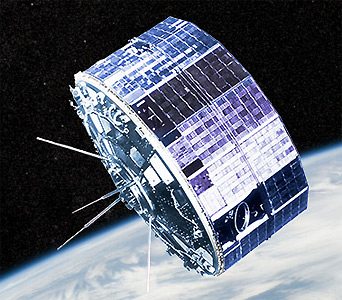Thank you very much for visiting Gunter's Space Page. I hope that this site is useful and informative for you.
If you appreciate the information provided on this site, please consider supporting my work by making a simple and secure donation via PayPal. Please help to run the website and keep everything free of charge. Thank you very much.
TIROS 9 / ESSA 1, ..., 9 (Operational TIROS)

ESSA 3 [NASA]
The ESSA series was the second generation of US meterological satellites after the TIROS (Television & Infra-Red Observation Satellite) series. They were also called OT (Operational TIROS), TOS (TIROS Operational Satellite).
This desiign was a spin-stabilized operational meteorological spacecraft designed to take and record daytime cloudcover pictures on a global basis for subsequent playback to a ground acquisition station. The satellite had essentially the same configuration as that of the TIROS series, i.e., an 18-sided right prism, 107 cm across opposite corners and 56 cm high, with a reinforced baseplate carrying most of the subsystems and a cover assembly (hat). Electrical power was provided by approximately 10,000 1- by 2-cm solar cells that were mounted on the cover assembly and by 21 nickel-cadmium batteries.
Two redundant wide-angle cameras were mounted on opposite sides of the spacecraft and canted 75 deg from the spacecraft spin axis. A pair of crossed-dipole command and receiving antennas projected out and down from the baseplate. A monopole telemetry and tracking antenna extended up from the top of the cover assembly.
There were differences in the imaging system acorss the series:
- TIROS 9 and ESSA 1 carried the same AVCS (Advanced Vidicon Camera System) as flown on previous TIROS mission, consisting of two 500 scan line TV cameras with 1.27 cm vidicons. At an altitude of 1450 km, the imaging system covered a 1200 km × 1200 km footprint with 3 km resolution.
- Even-numbered ESSAs (2, 4, 6, 8) carried the APT (Automatic Picture Transmission) system with two redundant APT cameras with 2.54 cm diameter vidicons and 108° wide angle 1/1.8 objective lense with a focla lenghth of 5.7 mm. The imaging system was programmed to take four or eight APT pictures per orbit
- Odd-numbered ESSAs (ESSA 3, 5, 7, 9) carried two AVCS (Advanced Vidicon Camera System) and the FPR (Flat Plane Radiometer) to measure the global distribution of reflected solar and long-wave radiation leaving the earth.
The satellites were placed in a cartwheel orbital mode, with its spin axis maintained normal to the orbital plane. The satellite spin rate and attitude were determined primarily by a Magnetic Attitude Spin Coil (MASC). The MASC was a current-carrying coil mounted in the cover assembly. The magnetic field induced by the current interacted with the earth's magnetic field to provide the necessary torque to maintain a desired spin rate of 9.225 rpm. Five small solid-fuel thrusters mounted around the baseplate provided a secondard means of controlling the spacecraft spin rate.
| Nation: | USA |
|---|---|
| Type / Application: | Meteorology |
| Operator: | ESSA |
| Contractors: | RCA |
| Equipment: | 2 × AVCS (#T9, 1, 3, 5, 7, 9); 2 × APT (#2, 4, 6, 8); FPR (#3, 5, 7, 9) |
| Configuration: | |
| Propulsion: | ? |
| Power: | Solar cells, batteries |
| Lifetime: | |
| Mass: | 138 kg (#T9, 1); 286 kg (#2, 4) 145 kg (#3, 5, 7, 9), 298 kg (#6, 8) |
| Orbit: | SSO |
| Satellite | COSPAR | Date | LS | Launch Vehicle | Remarks | |
|---|---|---|---|---|---|---|
| TIROS 9 (A 54) | 1965-004A | 22.01.1965 | CC LC-17A | Delta-C | ||
| ESSA 1 (OT 3, TIROS 11) | 1966-008A | 03.02.1966 | CC LC-17A | Delta-C | ||
| ESSA 2 (OT 2, TIROS 12) | 1966-016A | 28.02.1966 | CC LC-17B | Delta-E | ||
| ESSA 3 (TOS 1, TIROS 13) | 1966-087A | 02.10.1966 | Va SLC-2E | Delta-E | ||
| ESSA 4 (TOS 2, TIROS 14) | 1967-006A | 26.01.1967 | Va SLC-2E | Delta-E | ||
| ESSA 5 (TOS 3, TIROS 15) | 1967-036A | 20.04.1967 | Va SLC-2E | Delta-E | ||
| ESSA 6 (TOS 4, TIROS 16) | 1967-114A | 10.11.1967 | Va SLC-2E | Delta-E1 | ||
| ESSA 7 (TOS 5, TIROS 17) | 1968-069A | 16.08.1968 | Va SLC-2E | Delta-N | ||
| ESSA 8 (TOS 6, TIROS 18) | 1968-114A | 15.12.1968 | Va SLC-2E | Delta-N | ||
| ESSA 9 (TOS 7, TIROS 19) | 1969-016A | 26.02.1969 | CC LC-17B | Delta-E1 | ||
| ESSA 10 (TOS H) | - | cancelled |
References:
- TIROS 1, 2, 3, 4, 5, 6, 7, 8, 10
- TIROS 9 / ESSA 1, 2, 3, 4, 5, 6, 7, 8, 9 (OT, TOS)
- TIROS M / NOAA 1 / ITOS A, B, C
- NOAA 2, 3, 4, 5 / ITOS D, E, E2, F, G, H
- NOAA 6, B, 7, TIROS-N
- NOAA 8, 9, 10, 11, 12, 13, 14 (E, F, G, H, D, I, J)
- NOAA 15, 16, 17 (K, L, M)
- NOAA 18, 19 (N, N')
- NOAA 20 (JPSS 1)
- NOAA 21, 22, 23 (JPSS 2, 3, 4)
